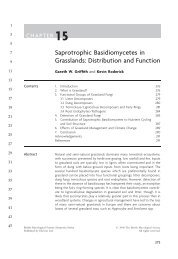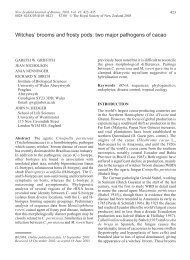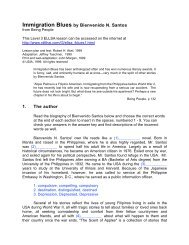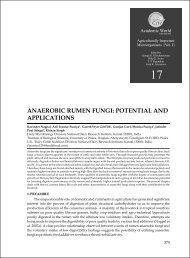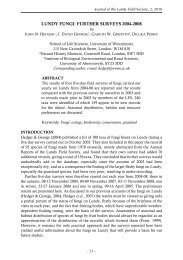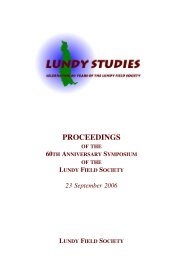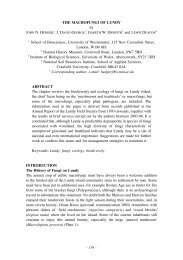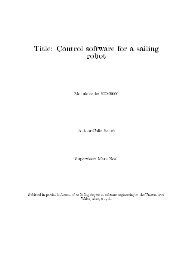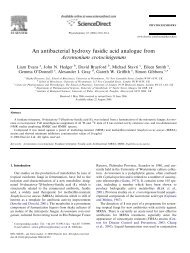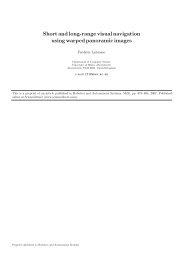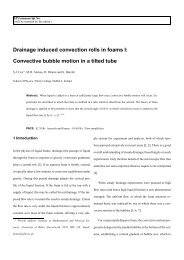Chytridiomycota - Users Site
Chytridiomycota - Users Site
Chytridiomycota - Users Site
You also want an ePaper? Increase the reach of your titles
YUMPU automatically turns print PDFs into web optimized ePapers that Google loves.
1966) and most have an electron opaque core in the<br />
transitional zone of the axoneme similar to the one<br />
found in some members of the Chytridiales.<br />
Clade 2C. Chytridiales.—Polychytrium clade. The two<br />
monotypic, polycentric genera Polychytrium and Lacustromyces<br />
and several monocentric species of Karlingiomyces<br />
make up the Polychytrium clade (formerly<br />
termed the Lacustromyces clade, James et al 2000).<br />
Polychytrium and Lacustromyces possess a rhizomycelium<br />
that lacks swellings containing nuclei (FIG. 1d).<br />
Polychytrium aggregatum is found in acidic lakes and<br />
bogs; Lacustromyces hiemalis occurs in lakes or<br />
commonly wet areas and Karlingiomyces can be<br />
isolated from aquatic or terrestrial habitats. Both the<br />
monocentric and polycentric species of this clade grow<br />
on chitin baits. Zoospores are spherical when in<br />
motion and usually larger than 4 mm diam. The<br />
unique ultrastructural feature of the clade is the<br />
composition of the kinetosome and its associated<br />
structures (Longcore 1993 unpublished). The nfc is as<br />
long as the kinetosome and the connection of the nfc<br />
to the kinetosome is distinctive. Densely staining<br />
material extends about 0.1 mm into the zoospore from<br />
kinetosome triplets 1 and 9; the primary microtubule<br />
root arises between these extensions. At the same level<br />
within the kinetosome is a scalloped ring (Longcore<br />
1993).<br />
Clade 2D. Chytridiales.—Cladochytrium. This clade<br />
(formerly Nowakowskiella) (James et al 2000) is a well<br />
supported lineage with a zoospore ultrastructure<br />
similar to Nowakowskiella elegans and Cladochytrium<br />
replicatum (Lucarotti 1981). It includes eight genera:<br />
Allochytridium, Catenochytridium, Chytridium (?) pro<br />
parte, Cladochytrium, Endochytrium, Nephrochytrium,<br />
Nowakowskiella and Septochytrium. Species in this<br />
group may be monocentric or polycentric and often<br />
are characterized by the presence of swellings in the<br />
rhizoids or rhizomycelium (FIG. 1e). They occur<br />
primarily on cellulose-rich substrates in aquatic and<br />
soil habitats. Members of the Cladochytrium clade have<br />
a zoospore that is typical for Chytridiales and most<br />
similar to that of the Chytriomyces clade (2K). One<br />
distinctive feature of the zoospore is that the microtubular<br />
root arising from the kinetosome is a cord-like<br />
bundle interconnected by fine fibrillar bridges (Lucarotti<br />
1981, Barr 1986). Two major subclades were<br />
recovered in our phylogenetic analysis. Nephrochytrium<br />
and Cladochytrium form a clade that is sister of a clade<br />
containing the remaining genera.<br />
Mycologia myco-98-06-18.3d 4/1/07 13:38:51 865 Cust # 06-083R<br />
JAMES ET AL: PHYLOGENY OF CHYTRID FUNGI 865<br />
Clade 2E. Chytridiales.—Synchytrium. This genus<br />
contains more than 200 species that are obligate<br />
parasites of green plants, particularly angiosperms.<br />
The four species of Synchytrium are monophyletic in<br />
the rDNA phylogeny (FIG. 2). The distinguishing<br />
feature of Synchytrium is colonial asexual reproduction<br />
by a sorus, a cluster of sporangia. The sorus of<br />
Synchytrium is derived by the internal cleavage of the<br />
common membrane of a single thallus into multiple<br />
sporangia. Synchytrium is included among Chytridiales,<br />
and the zoospore ultrastructure of two of the<br />
species generally conforms to the chytridialean type<br />
(Lange and Olson 1978, Montecillo et al 1980). The S.<br />
endobioticum (Lange and Olson 1978) zoospore contains<br />
an electron opaque plug at the base of the<br />
flagellum but lacks a fenestrated cisterna; in contrast<br />
the S. macrosporum zoospore has a fenestrated cisterna<br />
but lacks the electron opaque plug (Montecillo et al<br />
1980). Both species lack aggregated ribosomes observed<br />
in most other Chytridiales. Synchytrium spp.<br />
host ranges vary from broad (Karling 1964, S.<br />
macrosporum can be inoculated onto 165 different<br />
plant families) to narrow (S. decipiens is restricted to<br />
the genus Amphicarpaea).<br />
Clade 2F. Chytridiales.—C. angularise. Chytriomyces<br />
angularis is a monocentric, epibiotic, operculate<br />
fungus distinguished by a gibbous zoosporangium<br />
with thread-like rhizoids (FIG. 1f). Secondary rhizoids<br />
usually form several micrometers from the sporangial<br />
base and branch perpendicularly from the initial<br />
rhizoidal axis (FIG. 1f). In the literature fungi with<br />
this description were considered possibly to be an<br />
alternate form of C. poculatus. These fungi are<br />
recovered on pollen and snakeskin baits from soils<br />
or boggy areas and seem to be more abundant in<br />
acidic environments. This clade also includes Chytridium<br />
polysiphoniae, a parasite of the marine brown alga<br />
Pylaiella littoralis. Although C. angularis was classified<br />
a member of Chytriomyces based on its morphology<br />
and development, its zoospore (Longcore 1992) lacks<br />
features found in the Chytridiaceae (Letcher et al<br />
2005); instead it is characterized by a unique connection<br />
of the kinetosome and nfc (Longcore 1992).<br />
Clade 2G. Chytridiales.—Rhizophydium. This clade<br />
is composed primarily of members of the morphogenus<br />
Rhizophydium, which is characterized by a monocentric,<br />
epibiotic, inoperculate sporangium, an endobiotic<br />
rhizoidal axis that branches (FIG. 1g) and an<br />
epibiotic resting spore. Molecular studies with 28S<br />
r<br />
the kinetosome, nonflagellated centriole and associated structures. ‘‘N’’ indicates nucleus; ‘‘M’’ indicates mitochondrion.<br />
Ultrastructures are indicated for all clades except 2H (B. helicus) for which information is not available.



